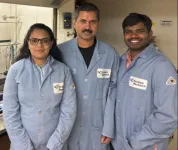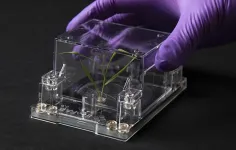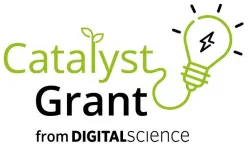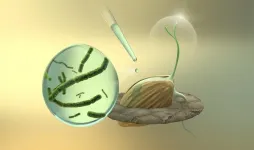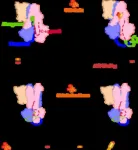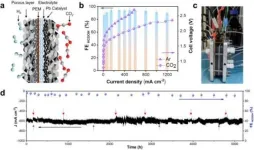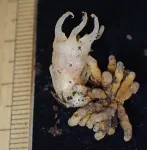(Press-News.org) Today, the Chan Zuckerberg Initiative (CZI) announced four multi-year grants that will bring together regional labs in California, the Mid-Atlantic, and the Research Triangle in North Carolina to explore the frontiers of genomics, cell biology, and synthetic biology by developing new measurement technologies. These projects will focus on developing technologies to engineer cell and tissue models, exploring cellular responses to genetic and environmental stressors, understanding RNA's role in metabolism, and more.
“To unravel the mysteries of the cell, we need new technologies, and the Exploratory Cell Networks grants support early-stage tech development driven by collaborations across regional labs,” said Stephen Quake, Head of Science at CZI. “These teams are developing novel tools and approaches to understanding, measuring, and engineering cells and molecules that are critical to building virtual cell models — which will open the door to new discoveries about human health and disease.”
Collaboration is a central component of the Exploratory Cell Networks grants, with each team comprising researchers from at least three different universities. Individual labs involved in the program have developed or envisioned foundational technological advances across biological scales — from genes to cell and tissue networks. Some projects involve computational biologists as partners and aim to generate new types of data that can be used for modeling or other artificial intelligence and machine learning approaches. Exploratory Cell Networks will accelerate the work of these groups by building regional networks of investigators. These Networks will unite nascent technology development that can be combined or bring broader expertise to help deliver or extend new measurement methods.
“We believe that scientific collaborations bring together new ideas and approaches that rapidly accelerate the pace of progress, making it natural for us to foster these enabling, cross-lab partnerships,” said Scott Fraser, CZI Vice President of Science Grant Programs. “Collaboration and building communities of researchers are central to our grantmaking strategy, and we’re excited to see what our new Exploratory Cell Networks teams will accomplish.”
Additional details about each project are as follows:
Exploratory cell networks to decode and program cellular behavior: The California Institute of Technology, the University of California, Los Angeles, and the University of Southern California will engineer, manipulate, and analyze complex multicellular systems, starting with muscle and immune cells. They will develop technology to study and control how tissues and organs develop their layered structure with synthetic cell receptors and develop new lab-on-a-particle approaches to probe the interactions between individual cells that drive cellular function at a massive scale. Findings from the project could help unlock a variety of cell and gene therapies to treat diseases such as cancer, muscular dystrophy and autoimmune conditions.
Innovative approaches for charting state-dependent RNA metabolic networks: The Salk Institute for Biological Studies, Scripps Research, and the University of California San Diego, will create a set of technologies to research RNA and cellular metabolism. These methods will clarify how cells respond and adapt to genetic and environmental stresses, including aging and diseases linked to RNA dysregulation, such as Alzheimer’s disease.
Revealing the hidden topologies of the human kinome: Duke University, NC State University, and the University of North Carolina at Chapel Hill will develop a suite of new tools capable of monitoring and manipulating protein kinases, which are not only key biological regulators but also a frequent target for therapeutic intervention. This work will help researchers better understand cellular organization, nervous system function, and neurological diseases.
Technologies for mapping RNA/protein flux, assembly, and aging through condensates: Princeton University, The Rockefeller University, and the University of Pennsylvania will develop technologies to clarify how RNA and proteins move and are metabolized within cells, with a specific focus on membrane-less compartments in cells. These new tools will fill a gap in foundational biology and may be helpful for understanding a core process impacting disease diagnosis and aging.
CZI’s work in science includes grantmaking programs, open-source software development, and close collaboration with its partner institutes at the Chan Zuckerberg Biohub Network. The CZ Biohub Network includes the San Francisco, Chicago, and New York Biohubs as well as the Chan Zuckerberg Imaging Institute. CZI also collaborates with institutional partners such as the Kempner Institute for the Study of Natural & Artificial Intelligence at Harvard University. For more information, please visit www.chanzuckerberg.com/science.
END
CZI announces multi-institutional collaborations for tech to better understand cells
These efforts will measure and engineer cellular function to better understand health and disease.
2024-02-29
ELSE PRESS RELEASES FROM THIS DATE:
Researchers uncover key therapeutic target involved in diabetic atherosclerosis
2024-02-29
Diabetes accelerates the development of atherosclerosis, increasing the incidence of cardiovascular events. In atherosclerosis, immune cells called macrophages release molecules such as chemokines and cytokines, causing inflammation and leading to arterial plaque formation. However, significant gaps persist in understanding the exact molecular mechanisms controlling this increased inflammatory response in individuals with diabetes. In a new, preclinical study, researchers from Brigham and Women’s Hospital, a founding member of the Mass General Brigham healthcare system, identified a long non-coding RNA (lncRNA) sequence that could help them unravel the ...
Scripps Research scientists reveal how first cells could have formed on Earth
2024-02-29
LA JOLLA, CA—Roughly 4 billion years ago, Earth was developing conditions suitable for life. Origin-of-life scientists often wonder if the type of chemistry found on the early Earth was similar to what life requires today. They know that spherical collections of fats, called protocells, were the precursor to cells during this emergence of life. But how did simple protocells first arise and diversify to eventually lead to life on Earth?
Now, Scripps Research scientists have discovered one plausible pathway for how protocells may have first formed and chemically ...
EcoFABs could lead to better bioenergy crops
2024-02-29
– By Will Ferguson
A greater understanding of how plants and microbes work together to store vast amounts of atmospheric carbon in the soil will help in the design of better bioenergy crops for the fight against climate change.
Deciphering the mechanics of this mutually beneficial relationship is challenging, however, as conditions in nature are extremely difficult for scientists to replicate in the laboratory. To address this challenge, researchers at Lawrence Berkeley National Laboratory (Berkeley Lab) created fabricated ecosystems or EcoFABs.
In a new paper in Science Advances, they ...
Digital Science announces Catalyst Grant winners, supporting AI-based innovations to benefit research
2024-02-29
Digital Science has awarded two new Catalyst Grants of £25,000 each to innovative AI-based technology ideas aimed at advancing global research.
The winners will use the funding to develop their ideas, which include using AI to alleviate the burden on researchers of applying for research funding, and to predict research impact.
The winning applications from Digital Science’s 2023 Catalyst Grant round announced today are:
Atom – Tomer du Sautoy (co-founder and CEO) and Hamilton Evans (co-founder and ...
Targeting seed microbes to improve seed resilience
2024-02-29
Fonio (Digitaria exilis), a type of millet, is the oldest indigenous crop in West Africa and one of the fastest maturing cereals. Despite its low yield, the combination of quick maturation and drought tolerance and its ability to thrive in poor soils make it a useful model for understanding how cereals can adapt to future climate change conditions.
Nutritionally, fonio is comparable to other millets, says KAUST researcher Naheed Tabassum, but yields are much lower than the major cereal crops rice, maize and wheat. Tabassum believes fonio could complement staple crops amid climate change and desertification ...
Astronomers discover heavy elements after bright gamma-ray burst from neutron star merger
2024-02-29
An international team of astronomers — including Clemson University astrophysicist Dieter Hartmann — obtained observational evidence for the creation of rare heavy elements in the aftermath of a cataclysmic explosion triggered by the merger of two neutron stars.
The massive explosion unleashed a gamma-ray burst, GRB230307A, the second brightest in 50 years of observations and about 1,000 times brighter than a typical gamma-ray burst. GRB230307A was first detected by NASA’s Fermi Gamma-Ray Space Telescope on March 7, 2023.
Using multiple space- and ground-based ...
USTC reveals molecular mechanism of transmembrane bilirubin transport by human ABCC2 transporter
2024-02-29
The metabolic process of bilirubin has been a focus in medical research since the abnormal accumulation of bilirubin has been found to be associated with a variety of diseases. Bilirubin is a substance produced by the breakdown of aging or damaged red blood cells, and its effective removal is essential for human health.
A research team led by Prof. CHEN Yuxing and Prof. ZHOU Congzhao from the University of Science and Technology of China (USTC) of the Chinese Academy of Sciences has revealed the three-dimensional structure and working mechanism of the human bilirubin transporter ABCC2. The study was published ...
USTC realizes durable CO2 conversion in proton-exchange membrane system
2024-02-29
The metabolic process of bilirubin has been a focus in medical research since the abnormal accumulation of bilirubin has been found to be associated with a variety of diseases. Bilirubin is a substance produced by the breakdown of aging or damaged red blood cells, and its effective removal is essential for human health.
A research team led by Prof. CHEN Yuxing and Prof. ZHOU Congzhao from the University of Science and Technology of China (USTC) of the Chinese Academy of Sciences has revealed ...
A new plant’s name that tells a story
2024-02-29
A new species and genus of fairy lantern, tiny glass-like white plants that feed on fungi, has been discovered in Japan. In the country renowned for its extensive flora research, the discovery of a new plant genus is extremely rare and has not occurred in almost 100 years.
Fairy lanterns, or Thismiaceae as they are known to botany, are very unusual plants found mainly in tropical but also in subtropical and temperate regions. First of all, they are not green and do not engage in photosynthesis, but rather feed on fungal mycelia in the ground. As a consequence, they are often hidden under fallen leaves and only for a brief period produce above-ground flowers that look like glasswork. The ...
Noteworthy studies to be presented at the 2024 Multidisciplinary Head & Neck Cancers Symposium
2024-02-29
PHOENIX, February 29, 2024 — Research on patient-centered treatment of head and neck cancers will be presented at the 2024 Multidisciplinary Head and Neck Cancers Symposium, which takes place in Phoenix and online today through March 2. Media registration is available via our press kit, and general registration is available via the meeting website.
Seven high-impact studies recommended by symposium leadership for media are noted below. All abstracts are available online. Experts are available to provide outside commentary and perspective on research at the meeting; ...
LAST 30 PRESS RELEASES:
Mysterious iron ‘bar’ discovered in famous nebula
World-first tool reduces harmful engagement with AI-generated explicit images
Learning about public consensus on climate change does little to boost people’s support for action, study shows
Sylvester Cancer Tip Sheet for January 2026
The Global Ocean Ship-Based Hydrographic Investigations Program (GO-SHIP) receives the Ocean Observing Team Award
Elva Escobar Briones selected for The Oceanography Society Mentoring Award
Why a life-threatening sedative is being prescribed more often for seniors
Findings suggest that certain medications for Type 2 diabetes reduce risk of dementia
UC Riverside scientists win 2025 Buchalter Cosmology Prize
SETI Institute opens call for nominations for the 2026 Tarter Award
Novel theranostic model shows curative potential for gastric and pancreatic tumors
How beige fat keeps blood pressure in check
Fossils reveal ‘latitudinal traps’ that increased extinction risk for marine species
Review: The opportunities and risks of AI in mental health research and care
New map reveals features of Antarctic’s ice-covered landscape
Beige fat promotes healthy vascular function and blood pressure in mice
Chronic low-dose pesticide exposure reduces the life span of wild lake fish, China-based study shows
Tiny earthquakes reveal hidden faults under Northern California
Long-term pesticide exposure accelerates aging and shortens lifespan in fish
Professor Tae-Woo Lee's research group develops groundbreaking perovskite display technology demonstrating the highest efficiency and industry-level operational lifetime
The “broker” family helps tidy up the cell
Ecology: Mummified cheetahs discovery gives hope for species’ Arabic reintroduction
Researchers survey the ADHD coaching boom
Air pollution and cardiac remodeling and function in patients with breast cancer
Risk of suicide in patients with traumatic injuries
Post–intensive care syndrome
The lifesaving potential of opioid abatement funds
The Frontiers of Knowledge Award goes to Allan MacDonald and Pablo Jarillo-Herrero for their discovery of the “magic angle” enabling science to transform and control the behavior of new materials
Discovery reveals how keto diet can prevent seizures when drugs fail
JMIR Publications and Sikt announce pilot flat-fee unlimited open access partnership
[Press-News.org] CZI announces multi-institutional collaborations for tech to better understand cellsThese efforts will measure and engineer cellular function to better understand health and disease.
